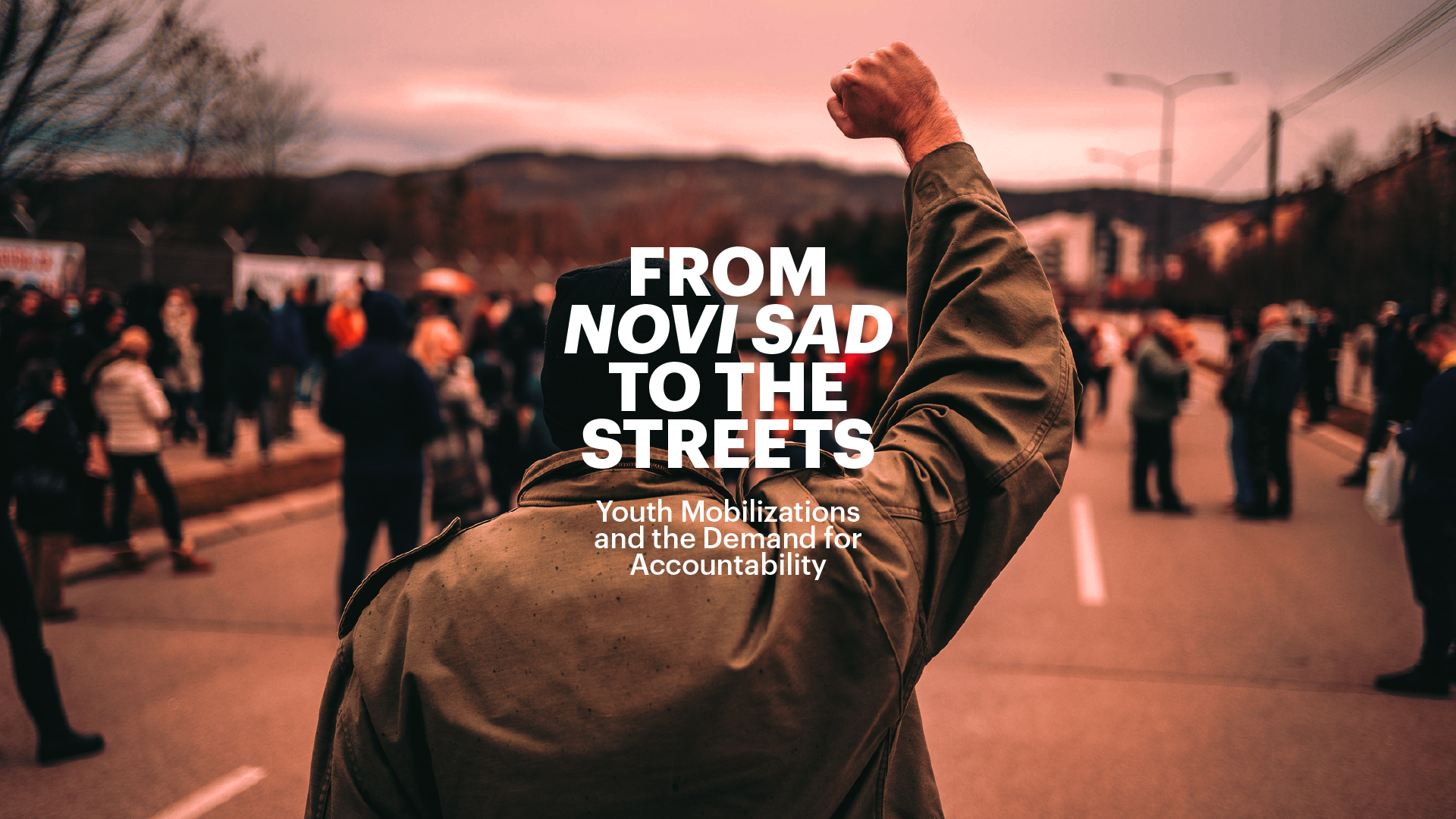
Milica Popović: Solidarity is essential. Just as neoliberalism is global, such must be our resistance.
1. The duration of the protests in Belgrade, now over 2 months, and their mass participation is remarkable. What is the cause of the protests taking place in Belgrade? What is fueling the social unrest and mobilizations? And what are the main demands of the protesters?
Significant protests in Serbia are a relatively common occurrence. March 9, 1991, the first mass protest in Belgrade against then-president Slobodan Milošević and the impending wars that dissolved socialist Yugoslavia, for some generations marked the beginning of thirty-four long years of protest, taking to the streets and shouting outside government buildings, fighting against the fear of police repression and security services intimidation. Almost everyone has a whistle at their home, ready to be taken out for another round of popular dissent.
On November 1, 2024, in Serbia’s second city, Novi Sad, the canopy of the main train station collapsed: fourteen people lost their lives. One of the wounded subsequently died, leaving fifteen victims and two people with serious injuries, who still remain in hospital. The station’s building has previously undergone several renovations and reconstructions, even being performatively opened twice, with billions of Euros invested and 82 different companies listed as subcontractors: from Serbia, Bosnia-Herzegovina, but also Hungary, China and France. On November 5, the first protests evolved after the initial shock, with a spontaneous citizens’ initiative of fifteen minutes’ silence every day at 11:52, the exact time of the tragedy. The initiative quickly spread across the country, and students began to join in. On November 22, during a protest action in front of the Faculty of Dramatic Arts in Belgrade, students were violently attacked by a well-organized mob, leaving some of them injured and all of them shocked. Three days later, they entered their faculty and started the first blockade, soon creating a list of precise demands: the identification and arrest of the responsible persons for the attack(s); the release of detained protestors and halt of any criminal procedures against them; the publication of complete documentation in regard to the reconstruction and the collapse of the train station canopy in Novi Sad; and an increase of the budget for higher education by 20%. As students of other faculties started joining, by December 13, all of the University of Belgrade was occupied.
Soon afterwards, several big protests took place gathering up to 100,000 people, but also daily street actions during which three students were hurt by intentional car hits and more were injured by direct violent attacks by the ruling party’s mobs. High school students and their teachers started organizing support for students, while many elementary and secondary schools joined the protests and entered into some form of strike. On 24 January, a general strike was organized bringing together unions of cultural workers and museums, a number of judges of the Higher Court in Belgrade, workers of the national electricity provider, the union of workers of that same Radio Television of Serbia, the National Bar Association, cinemas, theaters, actors, etc. Actions and protests continued to take place on a daily basis across 150 towns in Serbia. Agricultural workers joined student roadblocks with tractors to support the protests, with promises to provide safety to the students. The interclass solidarity continued to spread and to widen. On Monday 27 January a 24-hour blockade of a central highway in Belgrade was successfully organized, and from Thursday 30 January to Saturday 1 February several hundred students walked on foot from Belgrade to Novi Sad (distance of almost 100km) which ended with another spectacular protest bringing together students and citizens and blockade of the Novi Sad bridges. The unrest continues, and it spreads every day by including more and more strands of society.
2. We noticed that the protests are primarily directed against corruption? How is this related to the initial incident? Why is “corruption” chosen as a central element in the movement’s discourse?
Since the 1990s, Serbia has been reliving a Groundhog Day of perpetual struggle against authoritarian governments, corruption, so-called transition induced impoverishment, organized crime, and violence. To further cement the vicious circle, current leader Aleksandar Vučić—carrying the official title of President, yet with practical all-encompassing power—was part of the Milošević warmongering machine: in 1998, he was Minister of Information as a young, promising twenty-eight-year-old ethno-nationalist radical. Ten years later, in 2008, he created the Serbian Progressive Party (SNS) and since 2012, he has been in power inheriting the closely woven corrupt networks of government, security institutions, organized crime, and the corporate world. During his rule, the opposition parties have slowly disintegrated, despite some new political forces entering the field; these new groups are mostly transformed from previous social movements, meaning they lack party infrastructure and internal capacity to take up more significant space in the political panorama. This has certainly been further blocked by the state-controlled media space, but also by acts of intimidation and blackmail from regime henchmen. The opposition parties lost both their legitimacy and their appeal, and did not manage to win back popular trust after the disillusionment of their ruling years from 2000 to 2012. In a country economically devastated by decades of wars, sanctions, and imposed neoliberal transition that turned it into a semi-peripheral colony of cheap labor, and without any serious prospects for joining the European Union, providing a job or an apartment can go a long way. SNS carefully made large numbers of the population directly dependent upon them: the party has the highest number of members ever in the history of Serbian politics, estimated at almost 800,000. Such a context made it possible that, despite an undoubtedly high level of electoral fraud, Vučić’s party did indeed win all the elections in the last thirteen years.
So the cause of the fall of the canopy in Novi Sad was simply corrupted practices and the lack of respect of legal security protocols, but the root is the overall deep embeddedness of the ruling elites in these networks of capital, criminal and power.
3. Where do we stand at this point? What are the latest political developments after the recent resignation of Serbia’s Prime Minister? We see that despite Prime Minister Vucevic’s resignation, the demonstrations continue and maintain their mass and momentum. What action from the government would satisfy the majority of the protesters?
From the beginning of the protests, Vučić used his usual manipulation techniques: performatively “fulfilling” demands, either by publishing some irrelevant parts of the documentation, identifying some attackers but without prosecution, and each time simulating the openness of the regime, yet without truly hurting the governmental structures and associates. The regime’s bet was that the protests would fizzle out, just as they had every time previously, and especially with the upcoming New Year’s and Christmas holidays. The expectation was that soon enough, everything would return to normal: the prior order of lulled apolitical discontent. Once he realized the protests did not stop, but continued to grow he “sacrificed” the Prime Minister Vučević and the mayor of Novi Sad, indirectly offering new elections
The atmosphere in the country is on edge. Several days ago, in a restaurant in the center of Belgrade, one of the ministers and prominent leaders of SNS, Siniša Mali, was booed by other restaurant guests who started shouting expressions of support for the students, until the minister showed them a middle finger and took the phone out of the hands of a journalist who happened to be there and was filming the incident. On the other side of the powerful healing and motivating silence, and the ultimate democratic character of student plenums, stands the rising tension between citizens and the ruling party. In the background, in Belgrade, the flagship Hotel Jugoslavija, a gem of modernist architecture and a symbol of socialist Yugoslav times, has been demolished as a consequence of the comprehensive neoliberal erasure of the country’s once socialist future.
The movement continues to grow and the students stand firm that they are not demanding anything from the government – but from the state institutions. The provided amnesty from the President Vučić for the indicted protestors was rejected on the grounds that this should be a job for the state prosecutors, and not the President. So the demands of the students are in a certain way impossible for the government to fulfill – their fulfillment would mean the end of the corrupted rule of the party in power. It is fully unclear at this point to see how the whole situation will unravel.
4. What are the particular characteristics of these protests? How do they differ from previous ones? Are there any innovative elements? Do you notice anything different in terms of the forms of action or their frequency?
When in 2000, Otpor conducted the so-called October 5 revolution, those students were carefully trained and funded by the US and European powers. Now, the European Union is in great need of the lithium reserves in Serbia. As such, they are unlikely to support any instability that could jeopardize their secret deals with the regime, or support the environmental activists who have been protesting against Rio Tinto and the planned mines for years now. On January 26, Donald Trump’s Special Missions Representative Richard Grenell expressed his condemnation of violence and stated that the United States did not support the violent takeover of governmental buildings—funnily enough, as someone who supported the 2021 violent takeover of the Capitol—thereby indirectly expressing support to President Vučić. The European Union remained completely silent and seemingly uninterested, just as much as Beijing, while Moscow – like Washington – condemned the protests.
Another novel element, although tried before, is the principle of direct democracy being still – after almost three months of protests – successfully implemented. Students are organized in plenums, carefully ensuring they did not have leaders or any kind of hierarchical structure in the organization of protests and rejecting any interference by the opposition parties or any other interest groups.
5. Do you feel a sense of initial justice with the political consequences being recorded in Serbia? Is the lack of political accountability one of the most important problems for the functioning of democracy today? Are mass protests ultimately the only way to hold a government accountable?
There is certainly some satisfaction in the first (tiny) concessions by the government, but they are not satisfactory. The system needs to change, not specific personalities. Political accountability, but also criminal one in cases of such accidents which are men made tragedies, is important but it can only exist within a country with stable and independent institutions, as much as those are possible in a liberal democracy. Mass protests are indeed important, but they cannot be the only tool – a functioning democracy should have continuous possibilities of intervention into the system by the citizens. However, any significantly deep changes are difficult to imagine without changing the neoliberal capitalist structures, in today’s closely globalized world. So beyond the mass protests, there needs to be a strong political force capable of taking over and changing the regime. In current circumstances, the inseparability of the big capital and political forces is simply too strong for any long term changes to take root.
6. The people of Greece and Serbia share a common sense of pain and outrage and express solidarity with each other due to these two tragic events. We know that Serbian protesters took part in the recent large-scale demonstration for Tempi in Greece, and that Greek students are participating in and supporting the protests in Belgrade. How significant is this expression of solidarity? What message can we draw from such actions?
I believe citizens of Serbia and Greece share the understanding of the devastating consequences of being semi-peripheral countries, at the edges of the fortress Europe, turned into cheap labour colonies for the profit of the “developed” world. These events were not natural disasters but man-made tragedies that could have been avoided. Solidarity is essential, not only for breathing air into the optimism of the will of the precarious working classes, but because it imposes itself as the only avenue for acting in an interconnected world of global capital such as ours. Neoliberal acceleration in the last decades has shown the interdependency of the capitalist structures, most notably (yet again the only natural) alignment between the big capital and neo-fascist political forces. The extreme right is on the rise everywhere, and these regimes are a product of neoliberal democracies.
As previously mentioned, in the fall of the canopy at the train station in Novi Sad, in these corrupted deadly practices over 82 different companies were involved from five countries. Support to the authoritarian corrupted regime of Aleksandar Vučić comes from all big powers, both so-called liberal and so-called illiberal ones. Bringing them all to justice would require strong solidarity movements in all those countries. Just as neoliberalism is global, such must be our resistance.
*This interview was conducted on 3 February 2025.
Dr Milica Popović is Senior Postdoctoral Researcher at the Institute of Culture Studies at the Austrian Academy of Sciences, leading the project “The Silence of Saying No: (Un)Remembering Deserters from the Yugoslav wars”. Her main research interests are in the field of memory politics, nostalgia, museums, dissent and silence, with a focus on Southeast Europe.



